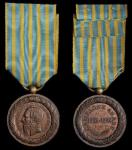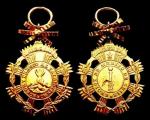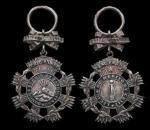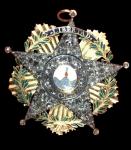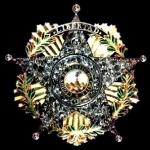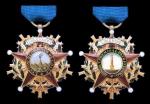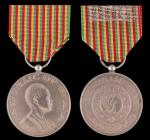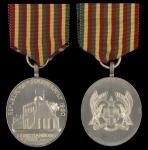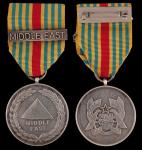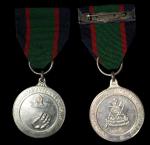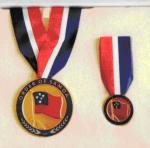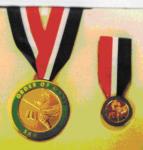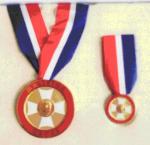-
Posts
3,944 -
Joined
-
Last visited
-
Days Won
32
Content Type
Profiles
Forums
Blogs
Gallery
Events
Store
Everything posted by Megan
-

Belgium Medal of the Arab Campaign 1892-1894
Megan replied to Megan's topic in Northern European & Baltic States
Thanks, Paul - and thank you for the hard copy catalogue which has just crawled through the letterbox -

Iranian Order of August (Nishan-i- Homāyūn)
Megan replied to JapanX's topic in Middle East & Arab States
Someone who's got around a bit... Ethiopia, Greece, Egypt, Iraq, Iran and Syria... but all fairly low level awards (5th classes, mostly) so not some high-powered diplomat... that is, assuming it is not just a random collection bunged on a medal bar. -

Belgium Medal of the Arab Campaign 1892-1894
Megan replied to Megan's topic in Northern European & Baltic States
This specimen is in the forthcoming Morton & Eden sale on 2 July (the dear souls there have given me the run of their catalogues...). If you like Belgian Congo stuff there are a couple of Type 1 Order of Leopold II items (Knight & Silver Medal) in the same sale. -

Belgium Medal of the Arab Campaign 1892-1894
Megan posted a topic in Northern European & Baltic States
Medal of the Arab Campaign 1892-1894 Médaille de la Campagne Arabe 1892-1894 Medaille van der Arabische Veldtocht 1892-1894 The Medal of the Arab Campaign was instituted in 1895 and awarded to members of the 'Force Publique' (Belgian colonial force in the Congo) for service in operations to expel Arab slavers from the territory 1892-1894. It is a dark bronze circular medal. The obverse shows the head of Leopold II, facing left, surrounded with the words LÉOPOLD II ROI SOUVERAIN DE L'ETAT INDET DU CONGO (Leopold II King Sovereign of the State of Congo) within a laurel wreath. The reverse bears the dates 1892-1894, with CAMPAGNE ARABE (Arab Campaign) below, also surrounded by a laurel wreath. The diameter: 32.4 mm and the weight 14g. The ribbon is striped yellow and pale blue, the colours of the Congo. -

Belgium Belgian order of Leopold ll
Megan replied to Laurence Strong's topic in Northern European & Baltic States
Here are some more images of the Type 1... Commander: Knight: Silver Medal: [Images courtesy DNW and Morton & Eden] -
This link is quite interesting: http://www.newvision.co.ug/news/656421-how-are-heroes-day-medals-given-out.html It tells of a National Honours and Awards Act of 2001 which set s out an array of honours and legislates how, to whom and when they should be awarded. To quote: "Medals and awards in Uganda are divided into military and civilian decoration and medals. In the latter category, the Most Excellent Order of the Pearl of Africa [The Grand Master] is the highest award in this class and it’s strictly bestowed upon heads of state and heads of government. It is closely followed by the Most Excellent Order of the Pearl of Africa [The Grand Commander] bestowed upon heads of states’ spouses, vice presidents and crown princes and crown princesses. "The Distinguished Order of The Nile [classes 1-v] is reserved to individuals who have distinguished themselves in productive research, economic, social and cultural enterprise. The Act provides that the Distinguished Order of the Crested Crane [Classes 1-V] is reserved for shinning lights in leadership - both in the private and public realms. For those who played a key role in the struggle for Uganda’s independence and those who have continued to protect it, the Act reserves them the National Independence Medal. "As for civilians who have contributed to the political development of Uganda either through armed struggle or civil disobedience, they are awarded the Nalubaale Medal. In the military category, The Order of Katonga heads the pack – a rare medal awarded to exceptional and extraordinary instances of heroism in the national army. In instances when the President is the beneficiary, only the Chief Justice shall have the honour of presenting The Order of Katonga. "The Kabalega Star [Classes 1-111) is second in rank to the Order of Katonga – awarded for conspicuous gallantly which does not merit the Order of Katonga. Third in this category is the Rwenzori Star [Class 1-111] for exemplary and distinguished service in the military which often entails great responsibility. There are four other categories that are used to reward Uganda’s heroes." At least we now know what we are looking for!
-

UN considers peacekeeping gallantry medal
Megan replied to ChrisW's topic in Rest of the World: Militaria & History
United Nations Security Council Distr.: General 8 May 2014 Resolution 2154 (2014) Adopted by the Security Council at its 7170th meeting, on 8 May 2014 The Security Council, Recalling Article 24 of the United Nations Charter which confers upon the Security Council the primary responsibility for the maintenance of international peace and security, Recognizing the medals presented by the United Nations to those men and women in uniform who serve in United Nations field operations, and recalling its Resolution 1121 (1997) establishing the Dag Hammarskjold Medal, as a tribute to the sacrifice of those who have lost their own lives as a result of service in peacekeeping operations, under the operational control and authority of the United nations, Recalling fundamental principles of the United Nations peacekeeping, as well as other relevant principles of the United Nations activities on the ground, Noting with deep appreciation how Captain Mbaye Diagne of UNAMIR and of Senegal, saved, unarmed and in the face of extreme danger hundreds of, perhaps even a thousand, Rwandans from death, during the 1994 Genocide against the Tutsi in Rwanda, during which Hutu and others who opposed the genocide were also killed, Recognizing with the deepest regret, how the family of Captain Diagne never received, after his death, any expressions of appreciation from the headquarters of the United Nations for the sacrifices made by their distinguished family member, Remembering the many other acts of bravery that military, police and civilian United Nations personnel and associated personnel have undertaken, while fulfilling the mandate of their missions or their functions, at great risk to their lives, 1. Decides to create “the Captain Mbaye Diagne Medal for Exceptional Courage” to be awarded to those military, police, civilian United Nations personnel and associated personnel who demonstrate exceptional courage, in the face of extreme danger, while fulfilling the mandate of their missions or their functions, in the service of humanity and the United Nations; 2. Requests the Secretary-General to establish within six months after the adoption of this resolution, the design of the medal, and to submit in due course to the Security Council the modalities for determining how the recipients of the medal shall be nominated and chosen, based on the criteria set forth in the previous paragraph; 3. Requests that the medal be presented by the Secretary-General to the recipient, or next of kin, in a ceremony to which all member states of the United Nations shall be invited; 4. Decides this medal will be ready for investiture within six months of the establishment of its modalities and the administrative management of the award will be provided by the Secretariat. -
A while back I asked for help in finding information about the ODM of Chile. Now I am busy putting together the results of my reseach. Legion of Merit of Chile Legion de Mérito de Chile The first award created in Chile was the Legion of Merit of Chile. It was instituted on 1 June 1817 by the Supreme Director Bernardo O'Higgins. In March of that year, he had abolished all titles and outward signs of nobility, and established the Legion to reward services to the nation or personal merit. Initially, awards were made to members of the army and other individuals who had fought for independence. The first type, awarded 1817-1820, was awarded in two classes, Gold and Silver. The Silver was only given to those who distinguished themselves in the Battle of Chacabuco in June 1817. Type 1 in Gold The badge was worn on a pale blue neck ribbon. It has eight rays joined by a laurel wreath with a scroll at the top. The obverse shows a volcano surrounded by the inscription HONOR Y PREMIO AL PATRIOTISMO. The reverse bears the inscription LEGION DE MERITO DE CHILE around a depiction of a column surmounted by a globe. The badge is 42 x 29mm, and the two classes differed only in the metal used. Type 1 in Silver In 1820, the Legion was amended to consist of four classes: Grand Officer (Grandes Oficiales de la Legion), Officer (Oficiales de la Legion), Sub-Officer (Sub-oficiales de la Legion) and Legionnaire or Member (Legionarios ó Miembros de la Legion). The class received depended on the rank of the recipient, with Generals becoming Grand Officers, Colonels becoming Officers, Majors becoming Sub-Officers and Lieutenants becoming Legionnaires. Those who were not in the army received an appropriate class of award to their station. All those awarded the Legion were required to swear on their honour to defend Chile, to sustain its liberty and independence and not to forget the duty and 'glorious distinction' for which they were decorated. They received certain privileges including an annual pension (Grand Officers received 1000 pesos, Officers 500 pesos, Sub-officers 250 pesos and Legionnaires they were 150 pesos), the right to be tried by a court of fellow Legionnaires rather than the civil or military court and they should be accommodated on any ranch free of charge when travelling around the country. The ribbon remained sky blue. Grand Officers wore the redesigned badge from a sash over the right shoulder with a star on the left breast. Officers wore a neck badge. Sub-Officers and Legionnaires wore breast badges, those of Sub-Officers being gold and Legionnaires silver. Type 2 Grand Officer Badge Type 2 Grand Officer Star Type 2 Sub-Officer This is all I have found for the Legion of Merit so far... and boy, did it take some hunting!
-
Yet another area that needs more work!!!!
-

Russian Federation Hero of Labour of the Russian Federation
Megan replied to TacHel's topic in Russian Federation
Thank you... but I still need a decent picture of the beast itself! -
The Republic Commemorative Medal (not quite sure what that's awarded for) apparently comes in different variations. This is the Police one. I haven't found any other versions yet.
-
The Republic Day Medal had a rather spotty history - originally instituted in 1960 it was discontinued in 1966 and then re-established in 1970, and again in 1979. The original version was a circular silver medal. The obverse showed the portrait head of President Nkrumah and the reverse bore the national arms surrounded by the inscription REPUBLIC DAY above and 1 JULY 1960 below. I've yet to find a picture of that. The current issue is an oval silver medal, but still on the same ribbon. On the obverse is Christianborg Castle with the inscription REPUBLIC DAY 1 JULY 1960 above and CHRISTIANBORG CASTLE underneath. The reverse shows the national arms. And here it is:
-
The Ghana UN Middle East Medal was awarded for participation in UN missions in the Middle East (as well as, presumably, whatever medals the UN itself handed out).
-
Just done a major update to the Ghana section of my website. This thread proved very useful, and I also must thank the good folks at Dix Noonan Web who kindly allowed me to use some very nice images from a sale back in December 2012. We've covered a lot here, but of course I've found out the odd thing along the way. The Order of the Star and Eagles of Ghana - which as you recall was instituted by the then President John Kufour basically for himself - was established by the National Honours Instrument of 2008, which was rescinded by the next President, Atta Mills, in 2010 although he very generously allowed anyone awarded an honour under its terms to retain and wear it! Still haven't found any decent images of the beast, though. Most of the other orders, decorations and medals of Ghana were instituted by the Honours Warrant of 1 July 1960. This was drafted by a British constitutional law specialist called Francis Bennion, who was also responsible for drafting the nation's constitution. Of course, as various events transpired, other medals were created to mark them - in particular, a succession of 'regime changes' brought about by revolts often led by the military. The Order of the Star of Ghana is the premier honour (apart from 2008-2010 when the Order of the Star and Eagles existed) is in 3 classes: Companion, Officer and Member. The Companion is worn on a sash over the right shoulder, but unusually there is no star associated with this class. Here's the Companion badge: The badge consists of a heavy seven-pointed star with square arms, with an eagle in the centre of the obverse. The reverse shows the national arms with the title of the award (including class) written around it. The Companion badge is all gold, the Officer silver with the eagle in gold and the Officer all silver. Here's the obverse of an Officer badge: And the reverse of a Member one: Now, Companions are quite often seen wearing an all-gold neck badge at the same time as they are wearing their sash badge - a quite unusual style, but one also seen with the Order of the Volta as discussed earlier in this thread.
-

Russian Federation Medal "For Distinction in Exercises"
Megan replied to TacHel's topic in Russian Federation
Thank you (scurries off in direction of website...) -

TRINIDAD AND TOBAGO
Megan replied to Antonio Prieto's topic in Rest of the World: Militaria & History
-
Still plugging away slowly - http://www.medals.org.uk/chile/chile-text.htm if you want to take a look. Getting a 'framework' sorted first, then I'll put in what ribbons I know and the images that I have found so far. It seems to be a very undocumented nation! Have found a few regulations, though, which helps. At least my Spanish is improving
-
Just about identified most in that picture, thanks (your ribbon charts are very good, as usual, Antonio) but the images are not good enough for my site (even if I had permission...).
-

Russian Federation New Defense Ministry medal "For the return of the Crimea"
Megan replied to TacHel's topic in Russian Federation
They were quick off the mark with this one! Like the way the ribbon reflects the Crimean flag, though. -
I am trying to work on the Chile section of my site, but am finding information and images hard to come by! Can anyone help? Here's one picture I found: a naval officer in 2009 at a commemorative service. Typing in any of the names of medals that I have found results in lots of pictures of award ceremonies, but most of the medals are very hard to make out!
-
-
Nice. Gongz, any chance that you'd let me use those on my website? With acknowledgement, of course.
-

Latin American awards exhibition
Megan replied to JBFloyd's topic in Rest of the World: Militaria & History
Amazing. Pity the catalogue is priced out of the reach of mere mortals... -
Well, that gives me a starting point: 7 variants x the different levels. Now to find images to illustrate it all... and slot them into the right places!
-
Even knowing the sequence of changes would be a start... dates could start being approximate and get more refined in due course. How many types of the beast are there?


